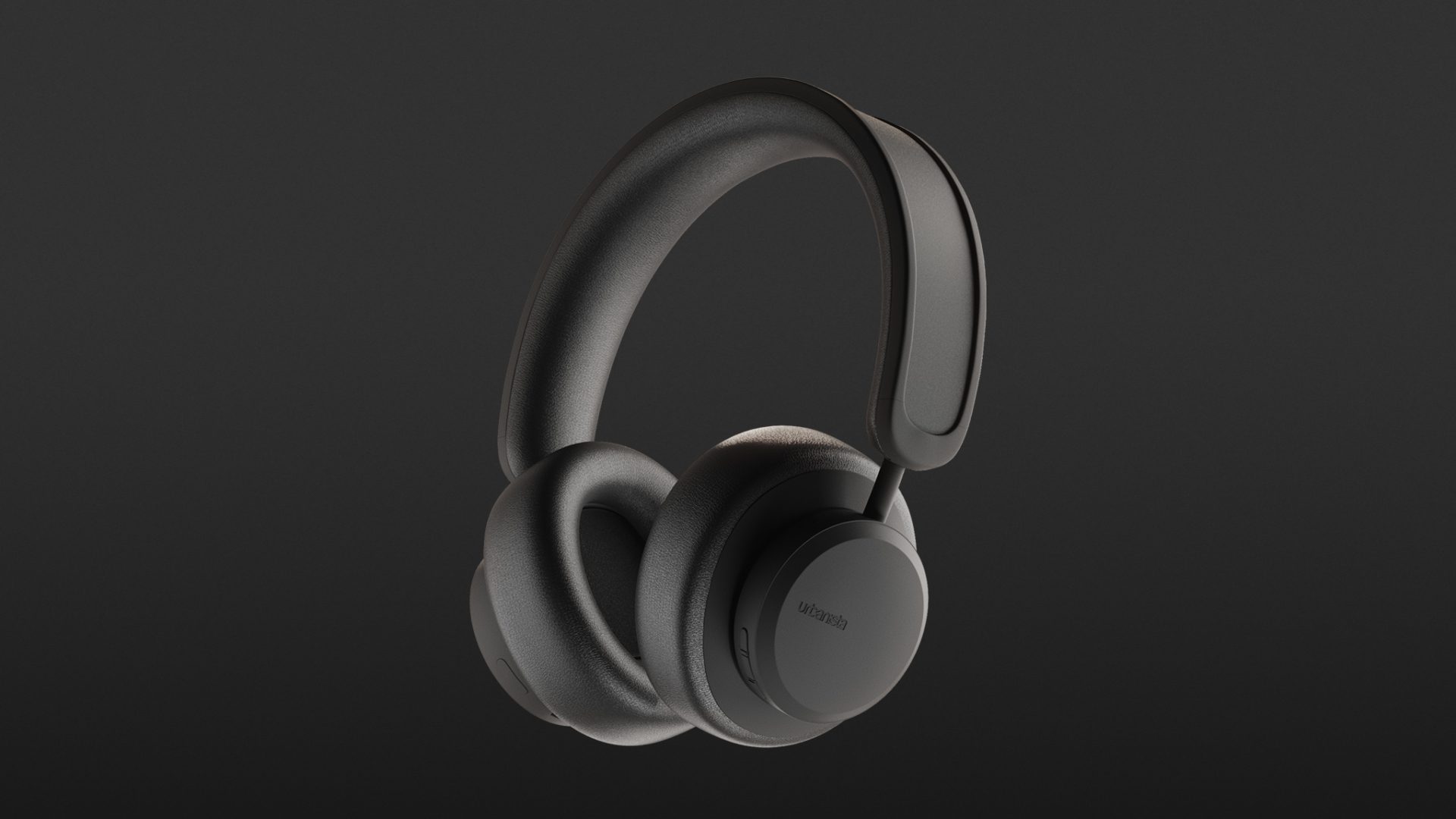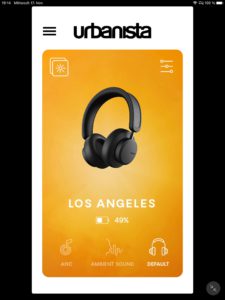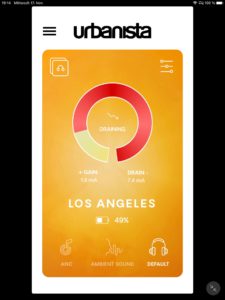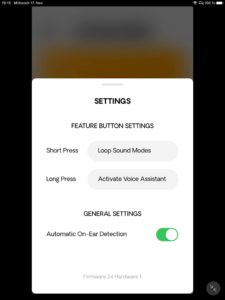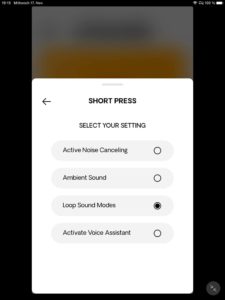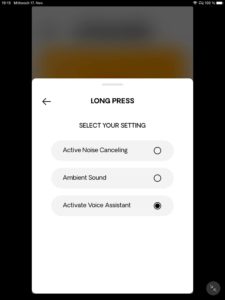Self-charging in light is an added value and an argument in favour of purchase; at the same time, it means the Urbanista Los Angeles stand out from the competition and take on a pioneering role. Especially since the extremely powerful battery offers a long runtime even in the darker winter months. The amplification and attenuation of external noise are also quite effective, although a slight background noise must be tolerated in ANC mode. The bass-emphasised tuning of these Bluetooth over-ears, on the other hand, is not really convincing, as the upper registers lack presence, especially at moderate volume levels. However, this could be remedied with the help of an EQ, which is why an option for sound adjustment in the app is at the top of the wish list for an update!
- Solar technology
- Very powerful battery
- Short battery charging time
- App connection
- Clever carrying case
- Support AAC format
- No aptX or LDAC
- ANC with slight background noise
- No 3.5 mm audio input
- The rather tight fit is not necessarily suitable for larger head shapes
The idea of a pair of solar-powered Bluetooth headphones starts to become a reality with the Los Angeles by Urbanista. Thanks to Powerfoyle solar cells, these over-ears can charge themselves – provided there is a light source.
Visually, the design of the Urbanista Los Angeles is unmistakably reminiscent of Urbanista’s Miami, although the Los Angeles are Bluetooth-only headphones, so there is no 3.5mm audio input for wired use. Another difference is the headband design, which is wider on the Los Angeles due to the integrated solar technology. However, there is no clear difference in weight, as this model weighs only twelve grams more at 322 grams. However, the fit seems a little tighter due to the wider earpiece, which is why these headphones are not necessarily recommended for larger head shapes. The ample padding also offers little room for large ears. Small to medium-sized head circumferences with corresponding ears, on the other hand, are offered a snug fit with stable support and a high level of shielding.
Powerfoyle technology
The top of the headband surface on the Los Angeles is made of a Powerfoyle solar cell from Swedish cleantech company Exeger, which is supposed to enable these headphones to continually recharge themselves in light. November in Germany is a pretty thankless month in which to test solar technology, but the self-charging still worked. According to our results, one hour of “November sun” provided battery capacity for two hours of listening, in basic mode, without noise cancellation, at high volume. It was also interesting to note that the headphones can charge not only in sunshine but in any light, albeit at a lower intensity. The difference is indeed noticeable, but an hour in a brightly lit office room in the evening darkness could still generate 25 minutes of listening time.
A well-implemented feature is that the included carrying and storage case leaves the headband surface exposed, which allows solar charging when not in use. By positioning these over-ears upright to the light in the sturdy bag, the effectiveness of energy harvesting can definitely be increased. A headphone stand is also very helpful, allowing alignment with the sun or room lighting.
Battery life
Aside from the integrated solar technology, the Los Angeles offer an extremely impressive runtime. Without any light, these over-ears reached almost 98 hours in an insulated room at high volume until the battery capacity was exhausted. With noise cancellation, they offered 72 hours of listening time. Another practical feature is that the battery only needs one hour and 45 minutes to be fully recharged via the USB-C connection. However, the supplied USB-C to USB-A charging cable could have been a little longer, as it only covers a distance of 15 centimetres.
If you are going to use the Los Angeles frequently, then you will probably have to recharge the headphones by cable every few weeks in the dark winter months. During the summer months, on the other hand, I think it’s quite realistic to imagine that these over-ears could be powered entirely by solar energy, as the much longer sunshine hours and higher position of the sun will favour self-charging.
Operation
These wireless headphones support Bluetooth version 5.0 and offer a stable range of twelve metres within an urban environment, which did not break off even across several rooms. The Los Angeles can be paired directly when switched on; this is done by briefly pressing and holding the middle remote button on the right earcup. When a wireless connection is established, the button also controls the start/stop function and is used to answer and end telephone calls. The volume, on the other hand, can be adjusted via the two side buttons, which, when pressed and held, also enable track selection by jumping forward with the plus button and back with the minus button.
To switch between ANC, ambient and basic mode, a separate function key is available on the left side of the headphones. This button can also be pressed and held briefly to activate voice assistants, and overall it works flawlessly. The Los Angeles’ Sensor-controlled wearer recognition can also be activated or deactivated via the app; here, playback is automatically paused when the headphones are put down and resumed when they are put back on.
App connectivity
In addition to switching the on-ear wear detection on and off, the Urbanista Audio app (Android and iOS) offers an option to adjust the function button assignment to your own needs. A graph also illustrates the ratio of energy generation and consumption, which makes it easy to understand how effective the self-charging of these headphones is. Another advantage is that the Los Angeles can be updated through firmware updates. However, the app does not currently offer an EQ for individual sound adjustment, and this would be a desirable addition.
Voice quality during phone calls
I noticed that the representation of one’s own voice can be impaired by background noise such as street noise when talking on the phone, as outside noise is not suppressed by the microphone technology. In a quiet environment, on the other hand, the Los Angeles offer impeccable speech intelligibility, especially since the person on the other end of the call is easy to understand.
Sound
The Los Angeles are tuned with a bass emphasis and convey an earthy, warm sound impression. The response and timing seemed relaxed rather than lively and fast. However, the sound image seemed rather dull and lacklustre, especially in bass-oriented productions, as the full low-frequency imaging was not precise enough. The low bass was compact, but cannot build up much pressure. With pop and rock, on the other hand, the powerful bass reproduction harmonised better, providing a full-bodied, throaty foundation. Voices were well intelligible and clearly brought out, which made these headphones suitable for spoken content as well, especially since sibilants are reproduced unobtrusively. The rather restrained treble reproduction does not tend towards sharpness or harshness even at loud playback levels and does not fall off. It is noticeable, however, that the upper registers only gain presence above a certain volume, which can make the basic sound seem cloistered during quieter playback. These over-ears do not support high-resolution audio codecs of the aptX family or LDAC. However, the higher-quality AAC format is available in addition to the Bluetooth standard SBC.
Noise cancellation and ambient mode
In ANC mode, there is a lowering of the bass range, which makes the low-frequency presentation appear significantly leaner, drier and more defined. At the same time, the sound image opens up, clears and appears brighter. In the lower frequency range, in particular, the noise suppression works quite effectively, while background voices or construction site noise can be noticeably attenuated, but still penetrate. What is filtered very well is keyboard rattling, which is barely audible. When playback is paused, however, slight background noise is perceptible, but this is not the case in ambient mode. This mode does not show any sonic difference to the basic tuning of the Los Angeles and offers a clean amplification of the outside world. Voices are very well understood so that even during playback it is still possible to react to fellow human beings at a medium volume. Moreover, the immediate surroundings are not completely faded out even at higher playback levels.
Technical specifications
- Ear couplingOver-ear
- Typeclosed
- Transducer principledynamic
- Frequency response (headphones)20 - 20.000 Hz
- Impedance±15 % @ 32 ohms
- Sound pressure level (SPL)@ 1 kHz ±3 107 dB
- Weight without cable322 g
- Cable length15 cm
What's in the box
- USB-C to USB-A charging cable
- Carrying bag (open at the bracket)
Special features
- Available in black and sand gold
- BT codecs: SBC, AAC
- BT version: 5.0
- BT profiles: A2DP 1.3, AVRCP 1.5, HFP 1.6






